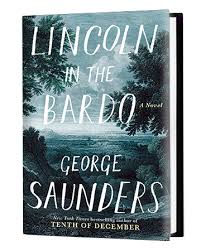Son of a bitch. That was a book.
You're going to need to pardon my enthusiasm here, but I'm going to go all "9th grade crush" on this thing. This is, without question, one of the best books I've read in years. It's also the kind of book that punches you right in the face on page one, then keeps you on the ropes for another 343.
It will also be almost impossible to explain.
First off, I'm going to admit something. I didn't know what a bardo was. I'm not a moron. I mean, I have an English degree. From a real college! But, I had never heard the word before. Because I had a basic idea of the premise of the book (stand by for that in just a second), I thought a bardo was a cemetery. It still would have made sense. But, it made so much more sense when I stopped about a quarter of the way through and Googled the word.
bar·do
ˈbärdō/
noun
- (in Tibetan Buddhism) a state of existence between death and rebirth, varying in length according to a person's conduct in life and manner of, or age at, death.
Got it? Now you're way ahead of where I was when I started. That's a free tip just for reading this blog!
So, Lincoln in the Bardo refers to Abe Lincoln and that state between death and rebirth. It's based on the historical note that, after his son Willie died, Lincoln would visit the cemetery alone, late at night, to visit his young boy. It's a heartbreaking footnote to history.
Before I explain more, you need to enter that state known as the willing suspension of disbelief. This isn't a memoir. It's not a biography. It's fiction. Got it? You're going to need to get in that head space.
The story of Lincoln's macabre nocturnal visit is told through other ghosts in the bardo. They're a motley cast of characters. Their diction is unusual, to say the least. The author paints a vivid, yet disturbing and distorted picture of each. And, the story volleys back and forth between them in abrupt paragraphs. It's wild. At first, it's really hard to read. Then, it sucks you into their world and you're off and running.
Those chapters alternate with snippets of historical information about the night young Willie died. Some are real tales, some are manufactured. Either way, they paint the "real life" picture of how Willie ended up in that crypt and how it crippled his surviving parents. You have to stay on your toes and the shift back and forth between the two can be jarring.
The book paints the picture of Civil War Washington, of a grief-stricken president, of a world none of us could even imagine. You feel not only his loss, but the lost hope in each of the deceased's unrealized dreams. Each soul is lingering, afraid or unable to succumb to the idea of death and move on to whatever is next. And you learn about the fate of the souls who linger too long.
President Lincoln's presence is unusual in many ways and, because of one shocking move, the dead see him differently than the others who come, lay their flowers and go. They fight to make their voices heard so that their stories might live on, Lincoln doesn't hear a thing.
It's a lot to pack in and it's done in such an unconventional way, you're on the edge of your seat, even if you don't end up appreciating the way it's told.
I appreciated it. I appreciated it very much.
You don't have to read a lot to get lulled into the idea that most books are pretty much the same. The stories differ, but the methods of telling them are largely the same. That's why books like this stand out so much. It's like someone reinvented the whole damn thing. It's the type of transformative literature you don't forget.
I'm so glad this was book 10 in this little adventure. It felt like a milestone. I'll warn you - it's not for everyone. If you prefer a little more of a predictable model of storytelling, this could very well give you a headache. But, if you know going in that it's going to be different and set aside your expectations of literature, you can get lost in an amazing world.


No comments:
Post a Comment